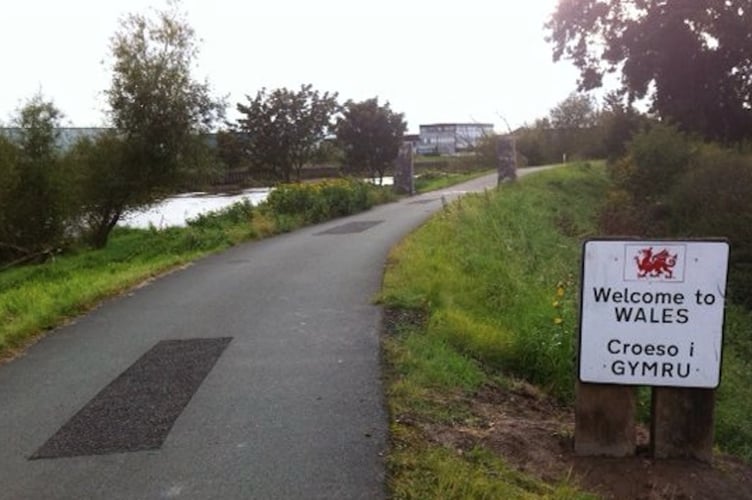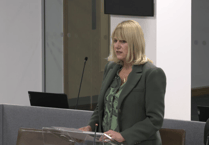The number of people who can speak the Welsh language has declined in Ceredigion and Gwynedd, census figures have revealed – prompting calls for radical interventions to secure its future.
Data released on 6 December by the Office for National Statistics (ONS) shows 45.3 per cent of people in Ceredigion can speak Welsh, which is down from 47.3 per cent since 2011.
Neighbouring Gwynedd, where more than two thirds of people can speak Welsh, saw only a 1 per cent drop in speakers, while Powys was down 2.2 per cent.
The number of Welsh speakers across the nation has gone from 19 per cent in 2011 to 17.8 per cent as of last year when the census, which is put together every decade, was compiled.
This equates to 538,000 people which is down 24,000 on the 2011 figure (562,000).
There was however an increase in speakers among those aged between 16 and 19, and 20 and 44 years old in the last decade. This was also true in Ceredigion.
Among those aged three to 15 years old, the proportion who could speak Welsh was down in all local authorities in the last decade – this is despite an increasing emphasis placed on learning the language in schools and its compulsory part of the GCSE curriculum.
In response, Plaid Cymru said the government target for one million Welsh speakers by 2050 is a ‘pipe dream’ without immediate ‘radical action’.
An ONS spokesperson said: “One of the main factors contributing to the overall decrease in the percentage of people who reported being able to speak Welsh between 2011 and 2021 was the decrease in children and young people aged three to 15 years who reported this skill.
“The percentage of usual residents aged three years and over able to speak Welsh decreased between 2011 and 2021 in all local authorities except Cardiff, Vale of Glamorgan, Rhondda Cynon Taf, and Merthyr Tydfil.”
Last week, different ONS data revealed that nearly half of Ceredigion’s residents regard themselves as Welsh before any other nationality, including British and English. This was the same for three in five of Gwynedd residents. But self-identification in both authorities has stagnated since 2011.
In contrast to national trends, figures show 47 per cent of people in Ceredigion identified as Welsh only when the census took place last year – equal to the proportion in 2011. The same could be said for 59 per cent of people in Gwynedd.
And 22 per cent of Ceredigion residents selected British only in the recent survey, while 20 per cent chose the option a decade ago. This was the same for 15 per cent of Gwynedd residents up from 14 per cent 10 years ago.
Census deputy director Jon Wroth-Smith said the recent data highlights that we are living in an ‘increasingly multi-cultural society’ across England and Wales, with fewer people saying they belong to a particular nation.
A statement from Elin Jones MS and Ben Lake MP – who represent Ceredigion – said: “The decrease shows that there continues to be a very real threat to the long-term viability of the Welsh language in Ceredigion. And the decline also emphasises the fact that, if it wasn’t for all the efforts to support the Welsh language in Ceredigion, the language could be in a far worse state today.
“What’s most disheartening is the 6.5 per cent decrease in three to 15 year-old Welsh speakers. This is surprising given the increase in provision of primary Welsh-medium education in Ceredigion over the last 10 years. Further analysis of this figure is needed and any information held by the education authority on school pupils will be informative in explaining this decline. More encouraging is the stabilisation in the number of adults under 65 speaking Welsh with no significant change since 2011.
“We must now redouble our efforts to put measures in place to promote and support the Welsh language. Global economic and demographic forces are at play that will always work against smaller, minority languages.
“The Welsh language belongs to us all and enriches our lives. We all have a stake in its future whether we speak it or not. It’s vital that we protect it for our future generations. Our language differentiates us from the rest of the world, but also enables us to understand multilingualism in a multilingual world.”
A Ceredigion County Council spokesperson told the Cambrian News: “The reduction in the percentage of Welsh speakers in Ceredigion as a result of the 2021 Census is disappointing.
“A number of factors could have contributed to this, including the decrease in Ceredigion’s population, the increase in the number of people over 65 living in the county, and the decrease in the number of young people settling here.
“While the number of Welsh speakers among school age children in Ceredigion remains strong, one of the main challenges for Ceredigion is trying to keep this group of Welsh speakers in our county, attract students back after graduating, and offer opportunities for young people to live and work here.
“To this end, one of the council’s main priorities, in line with our corporate strategy for 2022 to 2027, is to boost the economy.
“This includes creating jobs by attracting funding to Ceredigion through the Growth Deal, the Levelling Up Fund, the Community Regeneration Fund, and other projects.
“In addition, we are part of the Arfor 2 programme, and its main objective is to support communities that are strongholds of the Welsh language and enable them to flourish through economic interventions which will also contribute to increasing the opportunities to see and use the Welsh language on a daily basis.
“Our officers are always ready to support and advise anyone who is interested in establishing or expanding their business here in Ceredigion.
“The council has already approved the Welsh in Education Strategic Plan for 2022-2032, which outlines Ceredigion County Council’s desire that all pupils in the authority’s schools receive Welsh-medium immersion education until they are seven years old.
“A successful National Eisteddfod was held in Ceredigion this year and we hope that the legacy of this event will be to increase awareness of Welsh culture and the Welsh language in the county, leading to an increase in the number of people learning Welsh and raising the confidence of those who are shy of their Welsh.
“We can also build on what the Welsh Football Association has done to promote the Welsh Language and to normalise its use in our communities.
“The Welsh language belongs to everyone, and Ceredigion County Council is committed to ensuring that opportunities are available for all residents to take pride in their Welsh.”

This week, the latest report from the government’s Welsh language commissioner was discussed at a meeting of Ceredigion County Council. The report is designed to guide authorities to increase the use of the language in their regions. It found that nationally:
• 32 per cent of respondents are saying that the opportunities to use the Welsh language in their everyday lives have increased;
• 84 per cent of organisations’ websites are now available in Welsh;
• There has been an increase in the ability of organisations providing Welsh language services on social media.
But in contrast, the report found:
• 10 per cent of the Welsh speakers who were questioned choose not to use Welsh language due to the lack of availability of services, or an assumption that the service will not be of the same quality as the service in English;
• The Welsh language is treated less favourably than English in 50 per cent of job notices;
• The research shows that more people would be likely to use the Welsh language if organisations improved the way they delivered and ensured Welsh language services
A council officer’s report also said only 16 per cent choose the Welsh-language service when contacting the Ceredigion Clic Service, which is a much lower figure than the numbers who speak Welsh within the county.
In response to the ONS data, Robat Idris, the national chairman of campaign group for the advancement of the Welsh language, Cymdeithas yr Iaith, said: “The government has stated an intention to aim for one million speakers, but has not acted to ensure the necessary growth.
“[The] results show that switching gears must be made urgently – one practical thing the government can do now is set a goal in the new Welsh Education Act that all children will be educated through the Welsh language.
“By setting out a clear journey towards Welsh-medium education for all, we will ensure that future generations all come to speak Welsh, which would mean we can expect to see positive change from the 2031 Census onwards.
“Even more serious than the fact that the total number of Welsh speakers has fallen again, is the fact that our Welsh communities are under dire threat as local people are forced to leave due to a lack of homes affordable on local wages.
“We need to introduce a Property Act that will regulate the housing market, give more power to our communities and prioritise local people.
“What wonder really that there is a decline in the numbers of Welsh speakers? Currently 80 per cent of our young people leave school without being able to speak Welsh.
“Given its history, purposeful action is needed by the government if they are serious about the revival of the language.
“The decline of the Welsh language is not inevitable, but serious action is essential.
“The government and county councils must also consider the Welsh language in all policy areas, and not assign Welsh regeneration efforts solely to officers or departments responsible for the language.
“Reviving the language is a major effort that requires action across all policy areas.”
First Minister Mark Drakeford has already dismissed calls to educate all children through the medium of Welsh.
Minister for Education and the Welsh Language Jeremy Miles said: “The census figures are of course disappointing and not what we wanted to see.
“Census 2021 shows us one snapshot of what’s happened over the last 10 years. We’ll look at those results in detail alongside all the other statistics and research that’s available to us.
“I’ve often said that Welsh isn’t just something I speak, it’s something I feel, and I feel more and more people feel that the language belongs to them. The key is changing those feelings into language use.
“We’ll take time to examine the data carefully, in particular the figures relating to three to 15-year-olds. Covid-19 meant that 2021 was an extremely uncertain time, with many people concerned about their children’s Welsh language abilities, children were out of school, and it may be that we are seeing this concern reflected in the way they reported their children’s use of Welsh.
“The National Survey for Wales shows an increase in people saying they speak some Welsh. This contrasts with the census figures released [6 December].
“But we remain absolutely committed to our aim of a million Welsh speakers and doubling the number of us who use Welsh every day by 2050.
“The census shows us what has happened over the last ten years up to 2021. Cymraeg 2050 has been in place for less than four years of that period, and much of that time was affected by Covid-19. We’ve got good reasons to be optimistic about the next decade. Cymraeg belongs to us all in Wales.
“Today, we see more children in Welsh-medium education, more opportunities to learn Welsh, and greater pride in our language and our identity than ever before.”
Welsh Conservative Shadow Minister for the Welsh Language, Samuel Kurtz MS, said: “This is a deeply disappointing statistic that shows the Labour Government is further off meeting its Cymraeg 2050 ambition than it was when it set the target.
“While we fully support the ambitions of the Cymraeg 2050 target, the census’ data shows the stark reality of a tired government, in power for too long and out of ideas.
“Positivity around the language, showing that it is cool, modern and useable in day-to-day life is that way we can ensure the most beautiful language on Earth can flourish in its homeland.”
Mid and West Wales Senedd Member and leader of the Welsh Liberal Democrats, Jane Dodds said: “These statistics will be a great disappointment to all of us who care about a thriving future of the Welsh language and a truly bilingual Wales.
“Although there is a multitude of factors behind the decrease, one thing is clear: the depopulation of traditional rural heartlands of the language like Ceredigion, Ynys Môn, Carmarthenshire and Gwynedd must be halted if we are to ensure that usage of the language continues in everyday usage.
“These counties are losing many of their young people who move to more urban areas for work and who often then have less opportunity to use their Welsh skills. Providing jobs and investment in rural Wales is essential for the long-term protection of the language.”
Opinion is divided across Wales and its political parties. Can the long-term viability of the language rely on the existing policies of the Welsh government or are radical interventions now becoming unavoidable?





Comments
This article has no comments yet. Be the first to leave a comment.